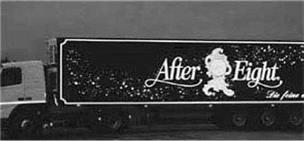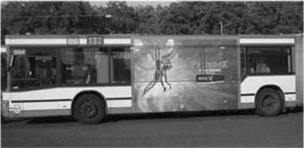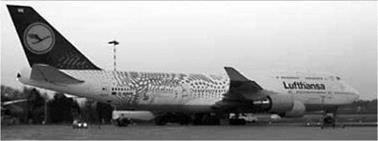A survey conducted by Infratest, Germany, has shown that traffic advertising reaches a target of 60% of the population. In this respect, mobile outdoor advertising is recognized as being highly effective, with 73% of drivers and passengers remembering it overall, and 31% remembering it in detail. The main target groups are buses and street or rail cars, with creatively designed vehicles contributing to the animation
|
Figure 8.74 Reflective advertising graphics on a truck. |
|
Figure 8.75 Modern traffic advertising. |
and entertainment of the street scene, particularly when combined with conventional billboard campaigns.
Often, a self-adhesive film is used to cover the entire side of a bus, windows included (Figure 8.75). In this case the inside window surface is provided with a special film that does not disrupt the passengers’ view, whereas people on the outside see a uniform picture.
Traffic advertising is especially suited to short-term advertising campaigns because it is inexpensive. Particularly in city centers, where large surfaces are only available to a limited extent; indeed, studies have shown that in this way target groups can be particularly well reached, notably the mobile, young and dynamic.
Today, aircraftgraphics arealsobecomingmoreinteresting (Figure8.76). Whereelse could an advertisement be placed so eye-catchingly in an international environment? A spectacular highlight of the World’s Fair Expo 2000 was a Lufthansa Boeing 747-400 decorated with a800 m2 Expo logo, which flewround the globe campaigning forthe first World’s Fair taking place in Germany. Working around the clock for two-and-a-half days, 30 Lufthansa employees assembled and applied the graphic from 270 film pieces.
The special graphic film was provided with a microperforation, was extremely weather-resistant, and could be stretched horizontally and vertically to prevent cracks from being generated during flight. The graphics were not applied to highly exposed components such as the wings, tail edges and areas where leakage of fuel or hydraulic fluid may have occurred. The film was a digital-printed graphic sealed with a screen-printed, two-part clear coat. Laminated film was not employed
|
Figure 8.76 Aircraft graphics. |
because lamination would close the pores. A protective coat was applied manually to the film edges in order to avoid detachment that might represent a safety risk.
Compared to painting, modern aircraft graphics technology has several advantages. Currently, as the majority ofairlines lease rather than buy their aircraft, graphic films allow the aircraft to be easily adapted to the corporate design of an airline. Hence, the visual implementation of short-term marketing campaigns is not a problem. Another benefit is that, unlike painting, bonding does not require a dust-free environment and need not be performed in specially prepared workshops. The time factor is another advantage — the bonding of a film is much faster than painting, and significantly reduces the aircraft’s expensive downtime.
8.13.4
 11 января, 2016
11 января, 2016  Pokraskin
Pokraskin 


 Опубликовано в рубрике
Опубликовано в рубрике 